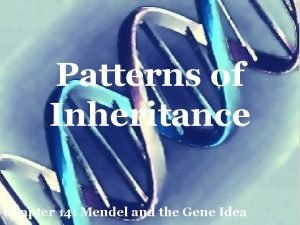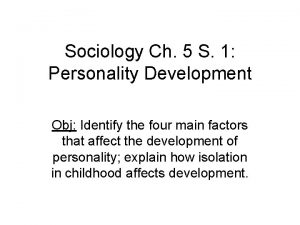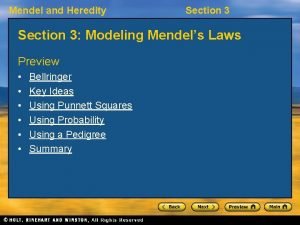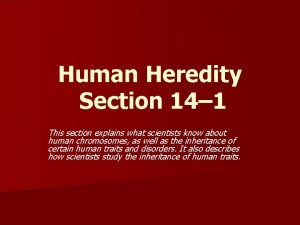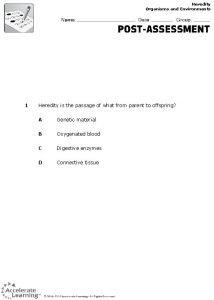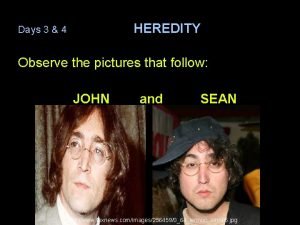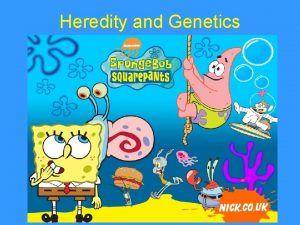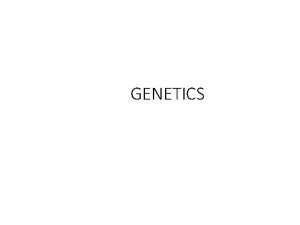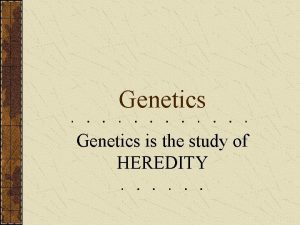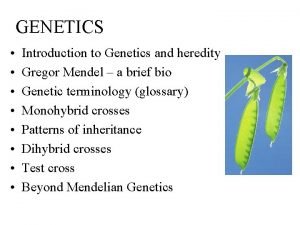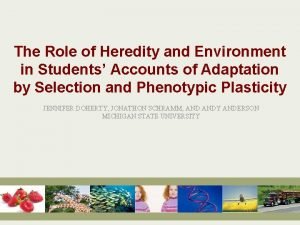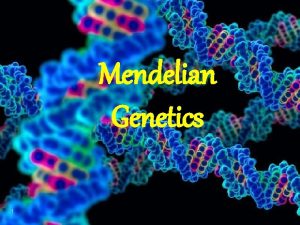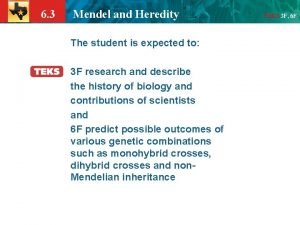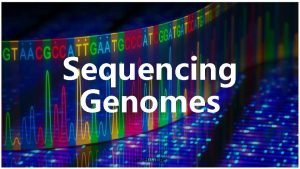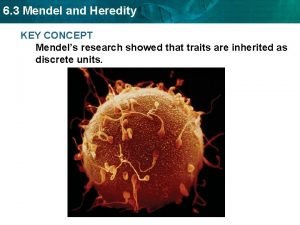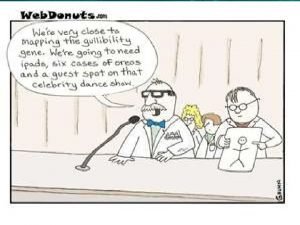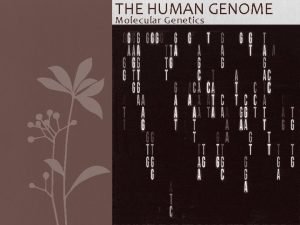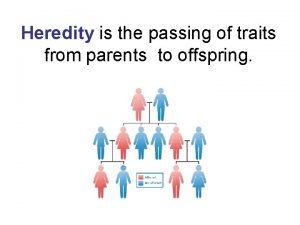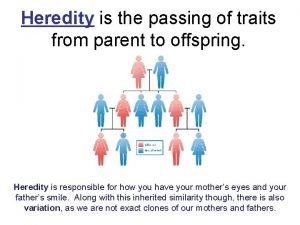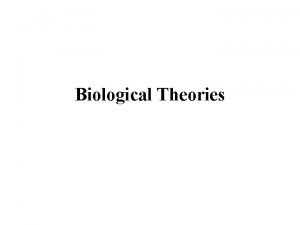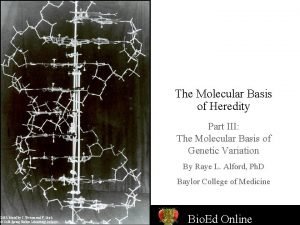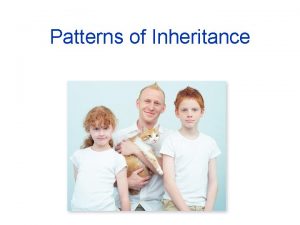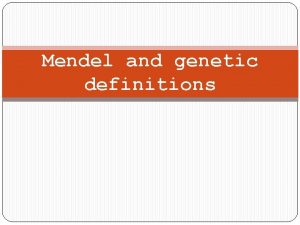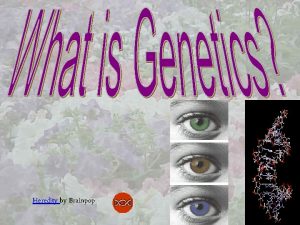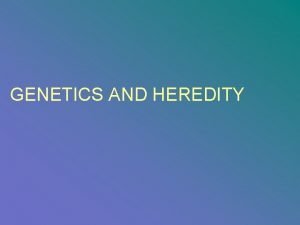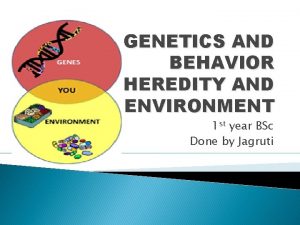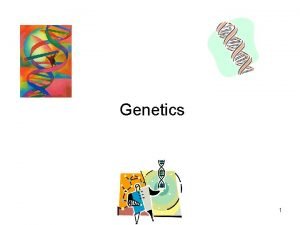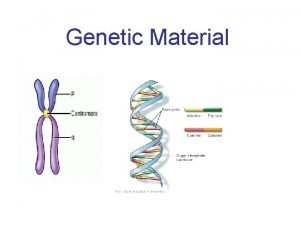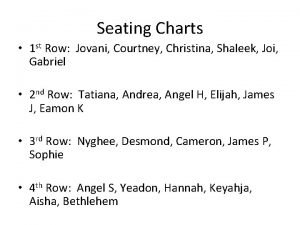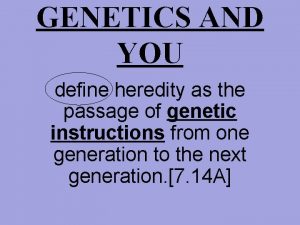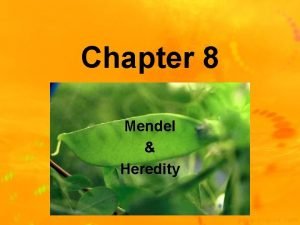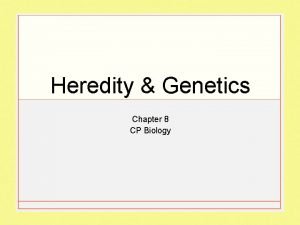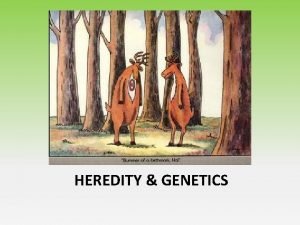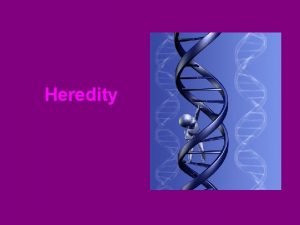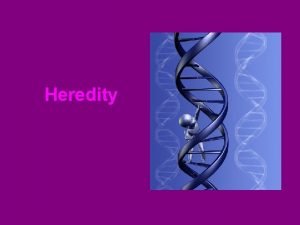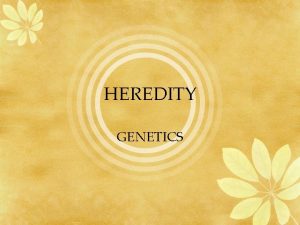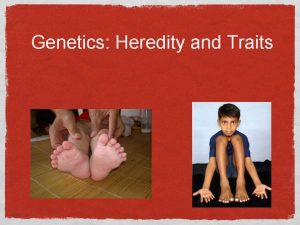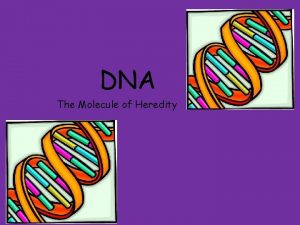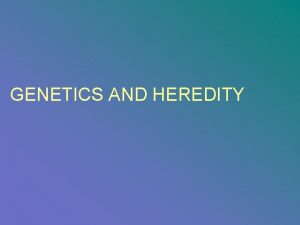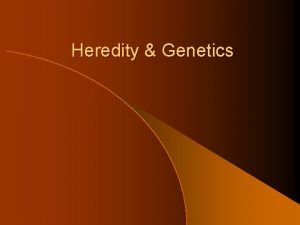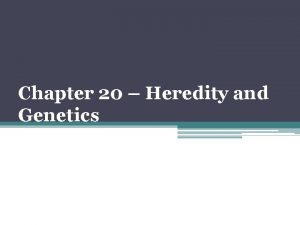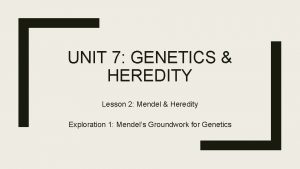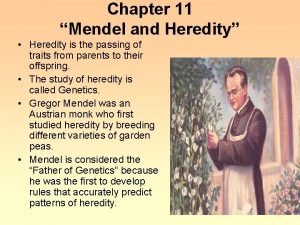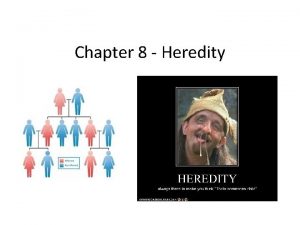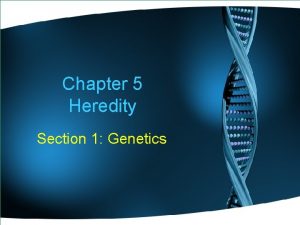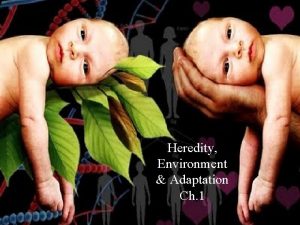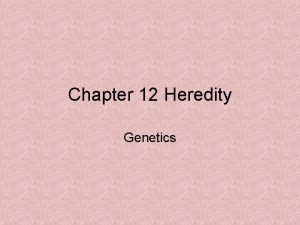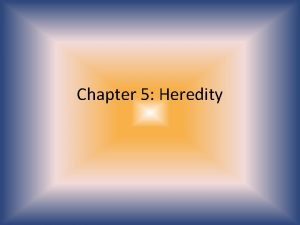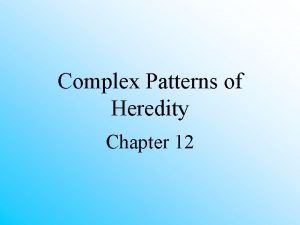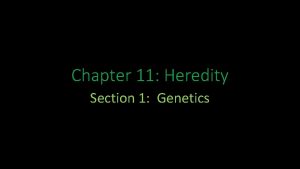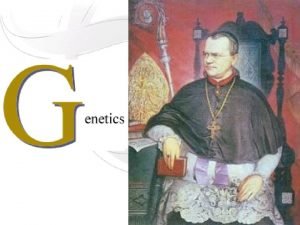Heredity Unit 3 Chapter 29 a Heredity Who
















































- Slides: 48

Heredity Unit 3 Chapter 29 a

Heredity �Who we are is guided by the genebearing chromosomes we receive from our parents in egg and sperm. �Segments of DNA called genes are blueprints for proteins, many which are enzymes, that dictate the synthesis of all of our body’s molecules.

Heredity �Genes are expressed in our hair color, sex, blood type and so on �However, these genes are influenced by other genes and by environmental influences

Genetics �Genetics is the study of the mechanism of heredity �Genes = give birth to �Nuclei of all human cells (except gametes) contain 46 chromosomes (or 23 pair) �Sex chromosomes determine the genetic sex (XX = female, XY = male)

Genetics �Karyotype – the diploid chromosomal complement displayed in homologous pairs – a picture of our genome �Genome – genetic (DNA) makeup represents two sets of genetic instructions – one maternal and the other paternal

Alleles �Alleles - Matched genes at the same locus on homologous chromosomes �Homozygous – two alleles controlling a single trait are the same �Heterozygous – the two alleles for a trait are different

Alleles �Dominant – an allele masks or suppresses the expression of its partner – represented by a capital letter �Recessive – the allele that is masked or suppressed – represented by a lower case letter

Alleles & Genotype �AA = both alleles dominate – homozygous dominant �Aa = one dominant allele and one recessive allele = heterozygous �aa = both alleles recessive – homozygous recessive

Genotype and Phenotype �Genotype – the genetic makeup �Phenotype – the way one’s genotype is expressed

Segregation and Independent Assortment �Chromosomes are randomly distributed to daughter cells �Members of the allele pair for each trait are segregated during meiosis �Alleles on different pairs of homologous chromosomes are distributed independently

Segregation and Independent Assortment �The number of different types of gametes can be calculated by this formula: 2 n, where n is the number of homologous pairs

Segregation and Independent Assortment �In a man’s testes, the number of gamete types that can be produced based on independent assortment is 223, which equals 8. 5 million possibilities

Independent Assortment Figure 29. 2

Crossover �Homologous chromosomes synapse in meiosis I �One chromosome segment exchanges positions with its homologous counterpart �Genetic information is exchanged between homologous chromosomes �Two recombinant chromosomes are formed

Crossover Figure 29. 3

Crossover Figure 29. 3

Random Fertilization �A single egg is fertilized by a single sperm in a random manner �Considering independent assortment and random fertilization, an offspring represents one out of 72 trillion (8. 5 million 8. 5 million) zygote possibilities

Dominant-Recessive Inheritance �Reflects the interaction of dominant and recessive alleles �Punnett square – diagram used to predict the probability of having a certain type of offspring with a particular genotype and phenotype

Dominant-Recessive Inheritance �Example: probability of different offspring from mating two heterozygous parents T = tongue roller and t = cannot roll tongue

Figure 29. 4

Dominant-Recessive Inheritance �Examples of dominant disorders: achondroplasia (type of dwarfism) and Huntington’s disease �Examples of recessive conditions: albinism, cystic fibrosis, and Tay. Sachs disease �Carriers – heterozygotes who do not express a trait but can pass it on to their offspring

�Now try some Punnet Square problems on you own!

Quiz next time! Study guide check Pages 713 -718 (6 points)

Heredity Unit 3 Chapter 29 b

Incomplete Dominance �Heterozygous individuals have a phenotype intermediate between homozygous dominant and homozygous recessive

Incomplete Dominance �Sickling gene is a human example when aberrant hemoglobin (Hb) is made from the recessive allele (s) SS = normal Hb is made Ss = sickle-cell trait (both aberrant and normal Hb is made) ss = sickle-cell anemia (only aberrant Hb is made)

Multiple-Allele Inheritance �Genes that exhibit more than two alternate alleles �ABO blood grouping is an example �Three alleles (IA, IB, i) determine the ABO blood type in humans �IA and IB are codominant (both are expressed if present), and i is recessive

ABO Blood Groups Table 29. 2

Sex-Linked Inheritance �Inherited traits determined by genes on the sex chromosomes �X chromosomes bear over 2500 genes; Y chromosomes carry about 15 genes

Sex-Linked Inheritance �X-linked genes are: �Found only on the X chromosome �Typically passed from mothers to sons �Never masked or damped in males since there is no Y counterpart

Polygene Inheritance �Depends on several different gene pairs at different loci acting in tandem �Results in continuous phenotypic variation between two extremes �Examples: skin color, eye color, and height

Polygenic Inheritance of Skin Color �Alleles for dark skin (ABC) are incompletely dominant over those for light skin (abc) �The first generation offspring each have three “units” of darkness (intermediate pigmentation) �The second generation offspring have a wide variation in possible pigmentations

Polygenic Inheritance of Skin Color Figure 29. 5

Environmental Influence on Gene Expression �Phenocopies – environmentally produced phenotypes that mimic mutations

Environmental Influence on Gene Expression �Environmental factors can influence genetic expression after birth �Poor nutrition can effect brain growth, body development, and height �Childhood hormonal deficits can lead to abnormal skeletal growth

Genomic Imprinting �The same allele can have different effects depending upon the source parent �Deletions in chromosome 15 result in: �Prader-Willi syndrome if inherited from the father �Angelman syndrome if inherited from the mother

Genomic Imprinting �During gametogenesis, certain genes are methylated and tagged as either maternal or paternal �Developing embryos “read” these tags and express one version or the other

Extrachromosomal (Mitochondrial) Inheritance �Some genes are in the mitochondria �All mitochondrial genes are transmitted by the mother �Unusual muscle disorders and neurological problems have been linked to these genes

Heredity Unit 3 Chapter 29 c

Genetic Screening, Counseling, and Therapy �Newborn infants are screened for a number of genetic disorders: congenital hip dysplasia, imperforate anus, and PKU

Genetic Screening, Counseling, and Therapy �Genetic screening alerts new parents that treatment may be necessary for the well-being of their infant �Example: a woman pregnant for the first time at age 35 may want to know if her baby has trisomy-21 (Down syndrome)

Carrier Recognition �Identification of the heterozygote state for a given trait �Two major avenues are used to identify carriers: pedigrees and blood tests

Carrier Recognition �Pedigrees trace a particular genetic trait through several generations; helps to predict the future �Blood tests and DNA probes can detect the presence of unexpressed recessive genes �Sickling, Tay-Sachs, and cystic fibrosis genes can be identified by such tests

Pedigree Analysis Figure 29. 6

Fetal Testing �Is used when there is a known risk of a genetic disorder �Amniocentesis – amniotic fluid is withdrawn after the 14 th week and sloughed fetal cells are examined for genetic abnormalities �Chorionic villi sampling (CVS) – chorionic villi are sampled and karyotyped for genetic abnormalities

Fetal Testing Figure 29. 7

Human Gene Therapy �Genetic engineering has the potential to replace a defective gene �Defective cells can be infected with a genetically engineered virus containing a functional gene �The patient’s cells can be directly injected with “corrected” DNA

Quiz next time! Study guide check Pages 719 – 726 (8 pts)
 Chromosome labeled
Chromosome labeled Chapter 11 human heredity section 11-3
Chapter 11 human heredity section 11-3 Chapter 11 complex inheritance and human heredity test
Chapter 11 complex inheritance and human heredity test Extra x
Extra x Dice and coin
Dice and coin Chapter 17 lesson 2 heredity and genetics
Chapter 17 lesson 2 heredity and genetics Unit 10, unit 10 review tests, unit 10 general test
Unit 10, unit 10 review tests, unit 10 general test Brainpop heredity worksheet answer key
Brainpop heredity worksheet answer key Heredity characteristics include body build
Heredity characteristics include body build Mendelian genetics concept map
Mendelian genetics concept map Section 3 mendel and heredity
Section 3 mendel and heredity 14-1 human heredity
14-1 human heredity Heredity is best described as the
Heredity is best described as the Pictures of heredity
Pictures of heredity Allele
Allele Genetics
Genetics ____________ is the study of heredity.
____________ is the study of heredity. Inheritance vs heredity
Inheritance vs heredity Genetics is the study of heredity and variation
Genetics is the study of heredity and variation Role of heredity
Role of heredity Section 3 mendel and heredity
Section 3 mendel and heredity Heredity terminology
Heredity terminology The basic units of heredity
The basic units of heredity Section 3 mendel and heredity
Section 3 mendel and heredity Heredity torrent
Heredity torrent Section 3 mendel and heredity
Section 3 mendel and heredity Section 3 mendel and heredity
Section 3 mendel and heredity Heredity
Heredity Heredity
Heredity Organisms that reproduce asexually
Organisms that reproduce asexually Heredity and crime
Heredity and crime Cpalms heredity
Cpalms heredity Molecular basis of heredity
Molecular basis of heredity Early ideas about heredity
Early ideas about heredity What is genotype
What is genotype Heredity
Heredity A gene carries the ________ for a trait. brainpop
A gene carries the ________ for a trait. brainpop Mendelian genetics vocab
Mendelian genetics vocab What is a pheontype
What is a pheontype Difference between heredity and environment slideshare
Difference between heredity and environment slideshare Heredity acrostic
Heredity acrostic Heredity
Heredity Flocabulary genes and heredity answer key
Flocabulary genes and heredity answer key Heredity is the passage of
Heredity is the passage of Heredity
Heredity Unit surplus dan unit defisit
Unit surplus dan unit defisit Right triangle trigonometry examples
Right triangle trigonometry examples English unit conversion
English unit conversion Algebra 2 unit 1 practice test
Algebra 2 unit 1 practice test




